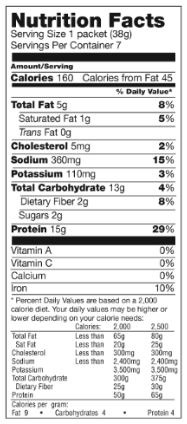Understanding nutritional labels can impact hunger, cravings and health.
Nutritional labels provide objective product specific information about the food that’s in the package, but don’t tell us all that we should know about the physiologic and behavioral impact that may be a consequence of eating that specific food. These labels do contain certain critical facts we need to be aware of before making an informed food selection, but in many ways omit the downstream implications of eating the recommended serving or, in many cases, the package. The first step to making a good food choice is to take the time to read the label. The second part is understanding the consequences of making a particular food choice.

Knowledge is Power!
Let’s take an informed look at what is actually contained in a typical Nutrition Facts label.
Serving Size:
The top of the nutritional label lists the serving size. This is the recommendation that the food producer has designated as a suggested portion. Often food manufacturers list a serving size that is unrealistically smaller than the amount most of us will actually eat. This practice over-estimates the number of servings per container, which is the second line on the label, while under-estimating the total calories that we will actually get, provided on the next line. For example, a bag of chips or crackers might be small, but the label indicates it contains 2 servings. If you eat the entire bag you are eating the full 2 servings, or double the calories and everything else on the label.
Calories:
Calories are essentially the amount of energy in a food. The table below indicates the amount of calories that comes from eating a gram of carbohydrates, fats and proteins.
| Component of Diet | Calories per gram |
|---|---|
| Fat | 9 |
| Protein | 4 |
| Carbohydrates | 4 |
Do not come to a false conclusion from reading this table. Americans have not become fat from eating fat. We have become overweight from our increasing reliance on the food industry for perceived nourishment, consuming quick-fix prepared and processed foods which are typically loaded with high glycemic carbohydrates, harmful hidden fats and sodium, and failing to understand their eventual adverse health consequences.
The two values given for Calories on the product label are the (Total) Calories and Calories from Fat, if we eat the exact portion size specified on the top of the label.
If you subtract the Calories from Fat from the Total Calories, you can see how many of the calories come from carbohydrates and proteins. Foods with nutritional value will have calories in them, so calories aren’t bad per-se. The trick is getting the right balance of protein, fats and carbohydrates, and the devil is in the details.
Total Fat:
The total fat per serving is listed on the nutritional label, and then subdivided to determine the amounts of saturated fat and trans-fat.
For years healthcare providers have demonized fat. It is now recognized that the consumption of healthy fats is critical to achieving and maintaining good health. Many believe healthy fats are important in controlling hunger and maintaining a healthy weight even though fats contain more calories per gram than protein and carbohydrates. It’s important to clarify that belief, and this is discussed further below.
The Combined Risks of Trans-Fat and Cholesterol
Cholesterol:
On nutritional labels, saturated fat and trans-fats are followed by cholesterol per serving. Although cholesterol has long been associated with an increased risk of cardiovascular disease, trans-fats are believed to be a more potent mediator of both coronary artery disease and stroke, in addition to type-2 diabetes. Trans-fats give us the double whammy in that they raise bad cholesterol (LDL) and lower cardio-protective good cholesterol (HDL). Trans-fats are produced by hydrogenating various vegetable oils, though small amounts are found naturally in certain animal products. Trans-fats are used in prepared and processed foods such as fried foods and shortening in crackers, cookies, and other snack foods, as well as in some margarines and margarine products.
The Trans-Fat Labeling Problem in the Food Industry
Trans-fats are a cheap ingredient used by the food industry to make their food more palatable, improving both taste and texture. Trans-fats also extend shelf life, improving profitability. FDA allows the food industry to falsely represent that there is zero trans-fat in the food if it contains less than a half gram of trans-fat per serving, which again is frequently underestimated by the food manufacturer. If we eat more than one serving or eat multiple foods containing less than a half gram of trans-fats, we are unknowingly exposing ourselves to adverse health risks.
The American Heart Association recommends that we minimize our consumption of foods containing saturated fats, cholesterol and trans-fats. Many healthcare professionals, including myself, believe that eating a diet emphasizing ‘non-fat’ processed foods directly contributes to the obesity epidemic. This statement is made recognizing that eating an excess of calories is linked to becoming overweight and obese. According to the National Institute of Health more than 2/3’s of adults are overweight and more than 1/3 are obese.
What we have failed to effectively emphasize as healthcare providers are the dangers of eating a diet rich in quick fix manufactured foods. We in fact can learn how to balance the various components of our diet to optimally match our metabolic needs and caloric intake to achieve optimal weight and health.
Healthy, Essential Fats
Not all fats are unhealthy. What you will NOT see on the Nutrition Facts label is a health-based breakdown of fats.
Certain fats are essential to maintaining good health. Omega-3 fatty acids found in oily fish like salmon, tuna, trout, mackerel, sardines and herring, and to a limited degree, from certain plants like flax, are just such fats. The balance between Omega-3 and Omega-6 fatty acids, both essential fatty acids, is critical to maintaining optimal health. (See our article on Fish Oil Supplements). Omega-6 fatty acids are a cheap source of fat used in overabundance by the food industry and include oils derived from various plants and nuts. Omega-3 fatty acids are anti-inflammatory, in contrast to Omega-6 fatty acids which cause inflammation.
In a typical Western diet, Omega-3 fatty acids are often under consumed while Omega-6 fatty acids are generally over consumed. Many Western illnesses are believed to be a result of excess inflammation, including cardiovascular disease, cancer and various autoimmune diseases such as rheumatoid arthritis.
Monosaturated fat found in certain plants, such as olives, is healthy fat and is thought to reduce the risk of heart disease. It may help with glucose control and thus help with diabetes. Good quality olive oil is a great source of antioxidants, which are believed to slow the wear and tear of our cells due to the accumulation of metabolic toxins known as free radicals. Polyunsaturated fats are predominantly from plants and thought to decrease risk of heart disease and may reduce the risk of type-2 diabetes.
There is a lot of information to digest, both in this article and on the Nutrition Facts labels. We will continue this discussion in a follow-up article that will include addressing hunger and cravings. Look for it in the coming weeks.



